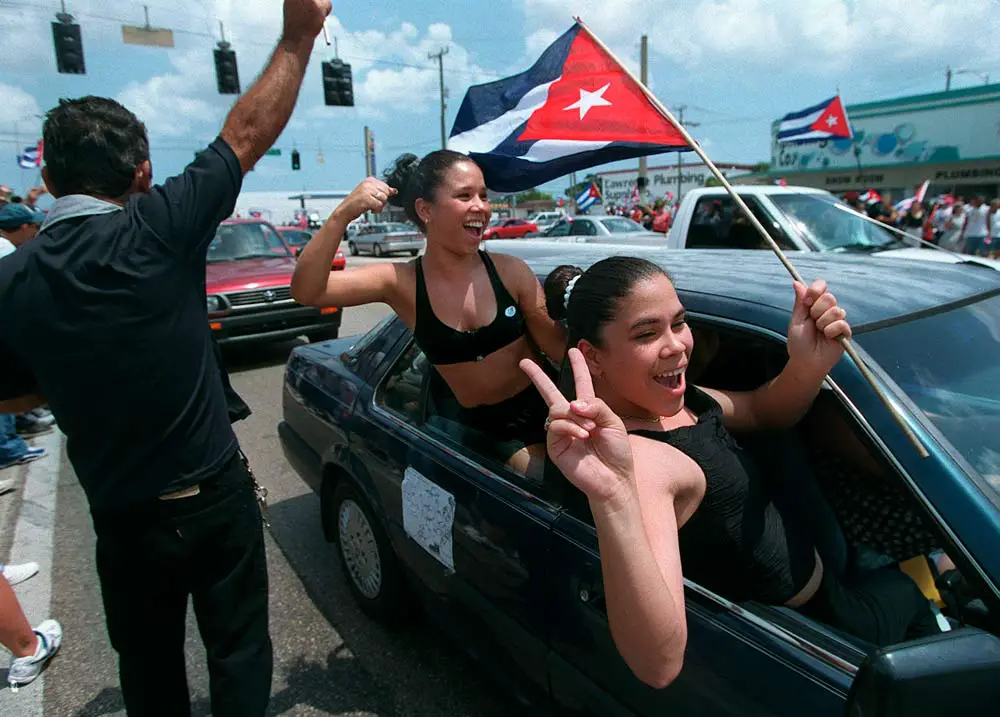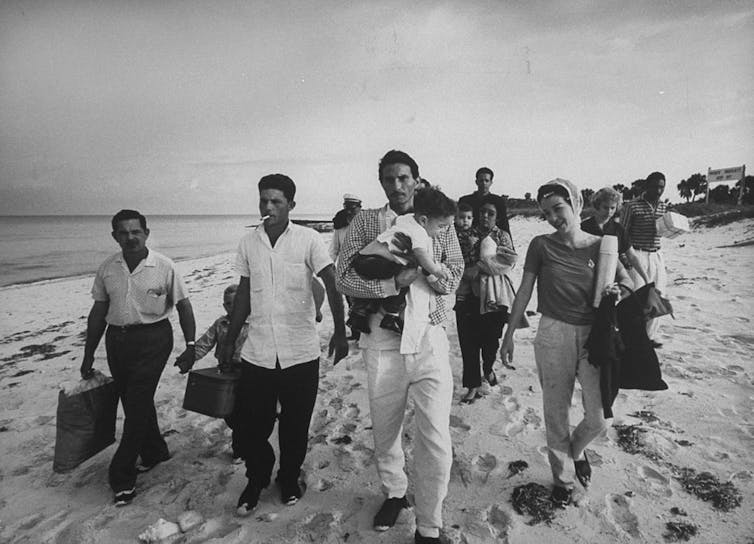
By Phillip M. Carter
“We got down from the car and went inside.”
“I made the line to pay for groceries.”
“He made a party to celebrate his son’s birthday.”
These phrases might sound off to the ears of most English-speaking Americans.
In Miami, however, they’ve become part of the local parlance.
According to my recently published research, these expressions – along with a host of others – form part of a new dialect taking shape in South Florida.
This language variety came about through sustained contact between Spanish and English speakers, particularly when speakers translated directly from Spanish.
When French collided with English
Whether you’re an English speaker living in Miami or elsewhere, chances are you don’t know where the words you know and use come from.
You’re probably aware that a limited number of words – usually foods, such as “sriracha” or “croissant” – are borrowed from other languages. But borrowed words are far more pervasive than you might think.
They’re all over English vocabulary: “pajamas” from Hindi; “gazelle” from Arabic, via French; and “tsunami” from Japanese.
Borrowed words usually come from the minds and mouths of bilingual speakers who end up moving between different cultures and places. This can happen when certain events – war, colonialism, political exile, immigration and climate change – put speakers of different language groups into contact with one another.
When the contact takes place over an extended period of time – decades, generations or longer – the structures of the languages in question may begin to influence one another, and the speakers can begin to share each other’s vocabulary.
One bilingual confluence famously changed the trajectory of the English language. In 1066, the Norman French, led by William the Conqueror, invaded England in an event now known as “the Norman Conquest.”
Soon thereafter, a French-speaking ruling class replaced the English-speaking aristocracy, and for roughly 200 years, the elites of England – including the kings – did their business in French.

Heritage Images/Hulton Fine Art Collection via Getty Images
English never really caught on with the aristocracy, but since servants and the middle classes needed to communicate with aristocrats – and with people of different classes intermarrying – French words trickled down the class hierarchy and into the language.
During this period, more than 10,000 loanwords from French entered the English language, mostly in domains where the aristocracy held sway: the arts, military, medicine, law and religion. Words that today seem basic, even fundamental, to English vocabulary were, just 800 years ago, borrowed from French: prince, government, administer, liberty, court, prayer, judge, justice, literature, music, poetry, to name just a few.
Spanish meets English in Miami
Fast forward to today, where a similar form of language contact involving Spanish and English has been going on in Miami since the end of the Cuban Revolution in 1959.
In the years following the revolution, hundreds of thousands of Cubans left the island nation for South Florida, setting the stage for what would become one of the most important linguistic convergences in all of the Americas.
Today, the vast majority of the population is bilingual. In 2010, more than 65% of the population of Miami-Dade County identified as Hispanic or Latina/o, and in the large municipalities of Doral and Hialeah, the figure is 80% and 95%, respectively.
Of course, identifying as Latina/o is not synonymous with speaking Spanish, and language loss has occurred among second- and third-generation Cuban Americans. But the point is that there is a lot of Spanish – and a lot of English – being spoken in Miami.

Lynn Pelham/Getty Images
Among this mix are bilinguals. Some are more proficient in Spanish, and others are more skilled English speakers. Together, they navigate the sociolinguistic landscape of South Florida in complex ways, knowing when and with whom to use which language – and when it’s OK to mix them.
When the first large group of Cubans came to Miami in the wake of the revolution, they did precisely this, in two ways.
First, people alternated between Spanish and English, sometimes within the same sentence or clause. This set the stage for the enduring presence of Spanish vocabulary in South Florida, as well as the emergence of what some people refer to as “Spanglish.”
Second, as people learned English, they tended to translate directly from Spanish. These translations are a type of borrowing that linguists call “calques.”
Calques are all over the English language.
Take “dandelion.” This flower grows in central Europe, and when the Germans realized they didn’t have a word for it, they looked to botany books written in Latin, where it was called dens lionis, or “lion’s tooth.” The Germans borrowed that concept and named the flower “Löwenzahn” – a literal translation of “lion’s tooth.” The French didn’t have a word for the flower, so they too borrowed the concept of “lion’s tooth,” calquing it as “dent de lion.” The English, also not having a word for this flower, heard the French term without understanding it, and borrowed it, adapting “dent de lion” into English, calling it “dandelion.”
A new lingo emerges
This is exactly the sort of thing that’s been happening in Miami.
As a part of my ongoing research with students and colleagues on the way English is spoken in Miami, I conducted a study with linguist Kristen D’Allessandro Merii to document Spanish-origin calques in the English spoken in South Florida.
We found several types of loan translations.
There were “literal lexical calques,” a direct, word-for-word translation.
For example, we found people to use expressions such as “get down from the car” instead of “get out of the car.” This is based on the Spanish phrase “bajar del carro,” which translates, for speakers outside of Miami, as “get out of the car.” But “bajar” means “to get down,” so it makes sense that many Miamians think of “exiting” a car in terms of “getting down” and not “getting out.”
Locals often say “married with,” as in “Alex got married with José,” based on the Spanish “casarse con” – literally translated as “married with.” They’ll also say “make a party,” a literal translation of the Spanish “hacer una fiesta.”
We also found “semantic calques,” or loan translations of meaning. In Spanish, “carne,” which translates as “meat,” can refer to both all meat, or to beef, a specific kind of meat. We discovered local speakers saying “meat” to refer specifically to “beef” – as in, “I’ll have one meat empanada and two chicken empanadas.”
And then there were “phonetic calques,” or the translation of certain sounds.
“Thanks God,” a type of loan translation from “gracias a Dios,” is common in Miami. In this case, speakers analogize the “s” sound at the end of “gracias” and apply it to the English form.
The Miami-born adopt the calques
We found that some expressions were used only among the immigrant generation – for example, “throw a photo,” from “tirar una foto,” as a variation of “take a photo.”
But other expressions were used among the Miami-born, a group who may be bilingual but speak English as their primary language.
In an experiment, we asked Miamians and people from elsewhere in the U.S. to rate local expressions such as “married with” alongside the nonlocal versions, like “married to.” Both groups deemed the nonlocal versions acceptable. But Miamians rated most of the local expressions significantly more favorably than folks from elsewhere.
“Language is always changing” is practically a truism; most people know that Old English is radically different from Modern English, or that English in London sounds different from English in New Delhi, New York City, Sydney and Cape Town, South Africa.
But rarely do we pause to think about how these changes take place, or to ponder where dialects and words come from.
“Get down from the car,” just like “dandelion,” is a reminder that every word and every expression have a history.
![]()
Phillip M. Carter is Associate Professor of Linguistics at Florida International University.




























Fernando Melendez says
This is so on point, you hit it on the nail. And this is true with basically all Hispanic cultures speaking their own forms of spanglish for example Puerto Rican will say in Spanish roofo a translation of the word roof when speaking with another Latino when talking about a rooftop when the correct word in Spanish is techo. Spanglish is totally another language of its own. And just to clarify fyi it’s bajate del carro or bajarnos del carro not bajar. But you were close tho because bajar does mean come down but would be used in a different context such as vamos a bajar la montaña, which means lets go the the mountain. And carro is really supposed to be coche in proper Spanish. Nice piece Pierre. At the end of the day we do understand each other and that’s what counts. Gracias mi hermano, Que viva America 🇺🇸 y dios te bendiga.
Brian says
The one time I was in Miami was for work. We needed AA batteries for a piece of equipment. Went to the 7/11 next to the job. Walked in and in my southern drawl asked the young clerk for the batteries. She spoke no English and that was all I spoke. But we worked together and made it work. Actually a good experience.
Fernando Melendez says
I hope you tried some of that authentic Cuban food while you were there.